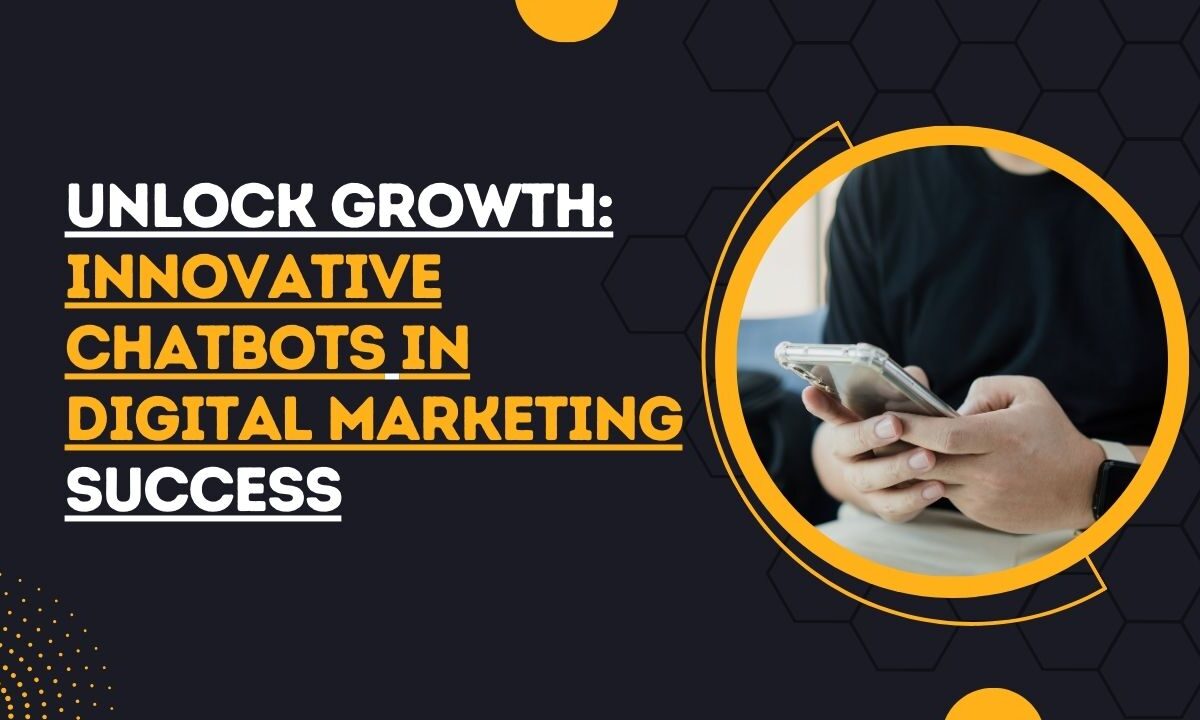Unlock Growth: Innovative Chatbots in Digital Marketing Success
Today we’ll talk about a game-changer in the digital marketing realm: chatbots. These little virtual assistants are shaking up the scene, revolutionizing the way businesses engage with customers.
These chatbots are boosting conversion rates like never before.
As per the latest on chatbot statistics ,“the chatbot market is set to expand at a remarkable 23.3% annually, reaching $15.5 billion by 2028“.
In this article, we’re diving deep into the world of chatbots and exploring their innovative uses in digital marketing.
From interactive storytelling to virtual shopping assistants, we’ve got it all covered.
So, buckle up and get ready to discover how chatbots are taking customer engagement to a whole new level.
1. Understanding Chatbots in Digital Marketing
1.1. Definition of Chatbots and Their Role in Digital Marketing
So what exactly are chatbots?
Simply put, chatbots are AI-powered virtual assistants that simulate human conversation. They live in messaging platforms, websites, and apps, ready to help users with questions, tasks, or even just a friendly chat.
Now, onto their role in digital marketing.
Chatbots actually work as your digital frontline warriors. Here’s what Learnfree says about chatbots:-
They engage with customers in real time, answer queries, provide assistance, and even guide them through the purchasing journey.
They’re like your 24/7 customer service reps, always ready to lend a helping hand.
Read More: Does Digital Marketing Really Work For Creating Wealth?
1.2. Importance of Personalized Customer Interactions in the Digital Era
In today’s digital landscape, personalized interactions reign supreme.
Customers expect businesses to understand their needs, preferences, and quirks. This is where chatbots shine!
With their ability to analyze data and adapt responses accordingly, chatbots deliver tailored experiences that make customers feel valued and understood.
Think about it: wouldn’t you prefer a personalized recommendation over a generic one-size-fits-all message? That’s the magic of chatbots—they make every interaction feel like a conversation with a friend, not just a transaction.
1.3. Benefits of Using Chatbot in digital Marketing
Now, let’s talk about benefits. Why should businesses hop on the chatbot bandwagon?
Well, for starters, chatbots are a game-changer when it comes to efficiency.
They can handle multiple conversations simultaneously, freeing up valuable human resources and reducing response times.
But wait, there’s more! Chatbots also enhance customer satisfaction by providing instant support round-the-clock. No more waiting on hold or dealing with frustrating automated phone menus.
With chatbots, help is just a message away.
And let’s not forget about the bottom line. By streamlining processes, improving customer engagement, and driving conversions, chatbots ultimately boost revenue and ROI for businesses. It’s a win-win situation!
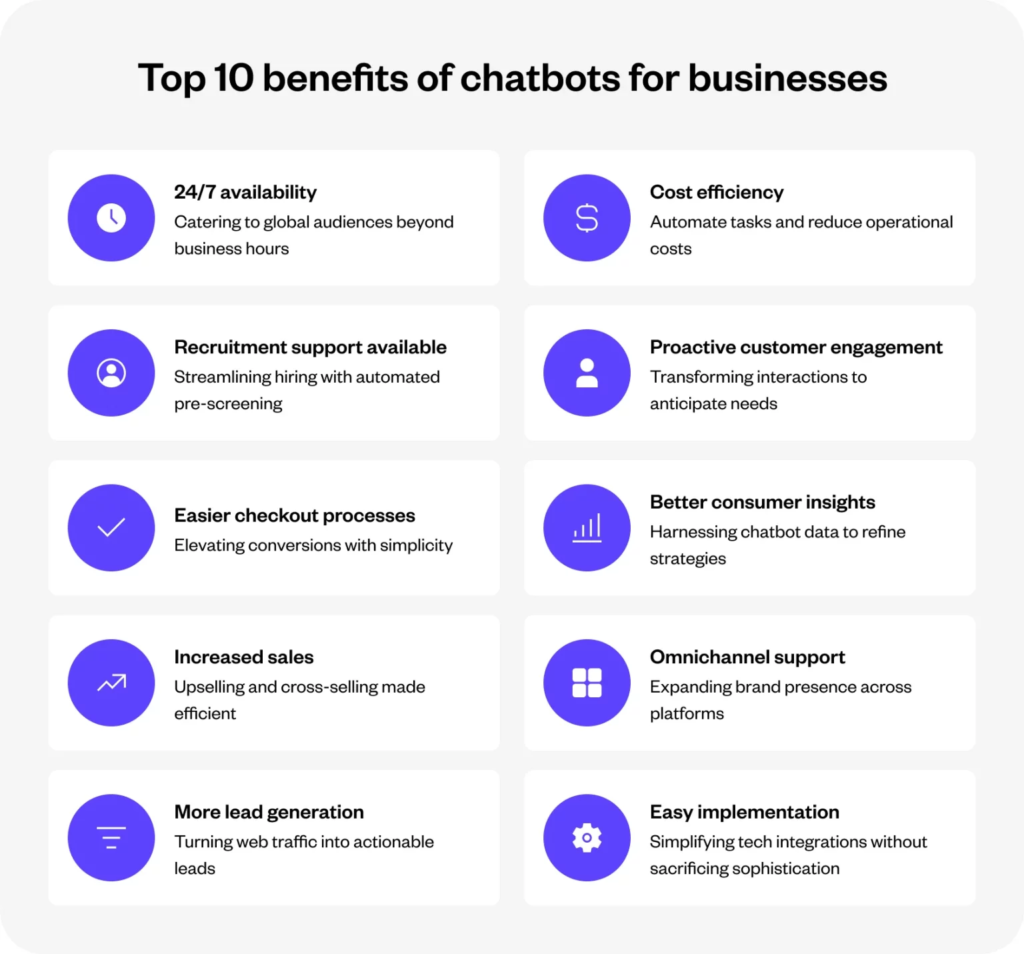
In a nutshell, chatbots are not just another tech fad—they’re a powerful tool for businesses looking to stay ahead in the digital marketing game.
Ready to harness their potential? Let’s dive deeper into their innovative uses.
2. Enhancing Customer Engagement With Chatbots
2.1. Providing Instant Responses to Customer Queries
One of the biggest perks of chatbots? Lightning-fast responses.
Gone are the days of waiting hours—or even days—for a reply to your customer inquiries. With chatbots, answers are delivered in real time, keeping customers engaged and satisfied.
Whether it’s a simple FAQ or a more complex question, chatbots are there to provide instant assistance, 24/7.
2.2. Personalizing Customer Interactions Based on Preferences and Behavior
Here’s where chatbots truly shine: personalization. By analyzing user data and behavior, chatbots can tailor interactions to each customer.
From recommending products based on past purchases to addressing customers by name, chatbots create a personalized experience that feels like talking to a trusted advisor.
It’s like having a virtual concierge who knows your every preference and anticipates your needs before you even ask.
2.3. Offering 24/7 Customer Support Through Chatbots
Picture this: it’s midnight, and a customer has a burning question about your product. In the pre-chatbot era, they’d have to wait until morning—or worse, give up in frustration.
But with chatbots, help is just a message away, no matter the time of day.
Whether it’s the middle of the night or a busy holiday weekend, chatbots are always on duty, ready to assist customers whenever they need it. Talk about convenience!
2.4. Implementing Proactive Engagement Strategies
Forget reactive customer service—chatbots are all about being proactive.
Instead of waiting for customers to reach out with questions or concerns, chatbots take the initiative.
They reach out to users with helpful tips, personalized recommendations, or timely reminders.
Whether it’s notifying customers of upcoming sales or offering assistance based on their browsing history, chatbots keep customers engaged and informed every step of the way.
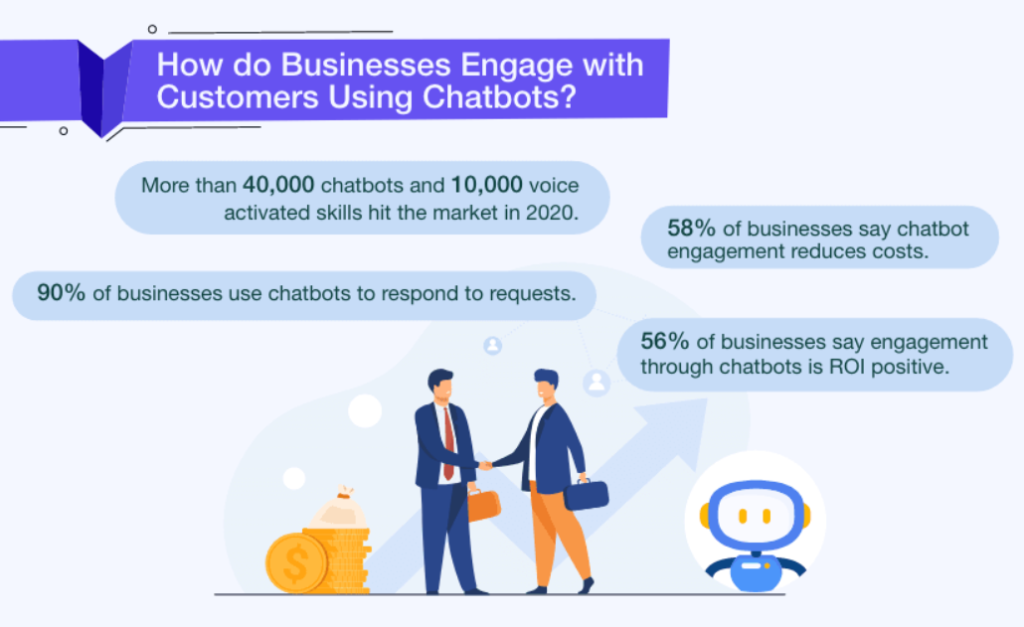
In summary, chatbots are not just tools for answering questions—they’re powerful engines for driving customer engagement.
Ready to see these strategies in action? Let’s explore some innovative use cases next.
Read More: Digital Marketing Secrets: And How To Succeed At Personal Branding
3. Driving Conversions Through Chatbots
3.1. Guiding Customers Through the Sales Funnel
Chatbots are like personal shopping assistants, guiding customers every step of the way through the sales funnel.
DigitalMarketer specializes in chatbot sales funnels, take a look:-
From the awareness stage to the final purchase decision, chatbots provide valuable information, address concerns, and offer assistance tailored to each customer’s needs.
By streamlining the buying process and removing friction points, chatbots make it easier than ever for customers to make a purchase, ultimately driving conversions.
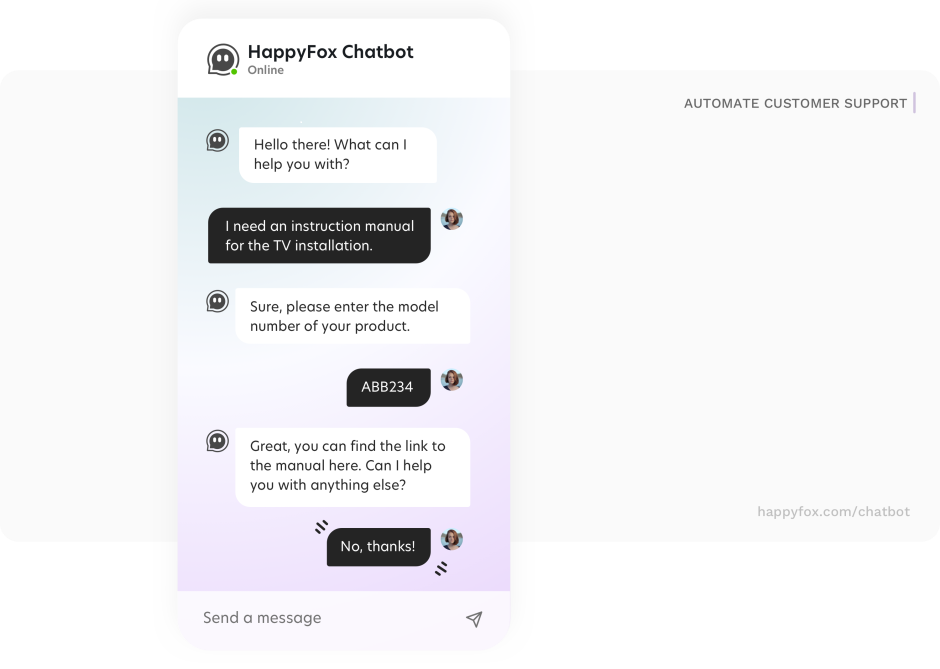
3.2. Offering Product Recommendations and Upselling Opportunities
Want to boost sales and increase average order value?
Look no further than chatbots.
Using data analysis and machine learning algorithms, chatbots can recommend products that are perfectly suited to each customer’s preferences and past purchases.
Whether it’s suggesting complementary items or highlighting exclusive deals, chatbots help customers discover new products they’ll love.
Simultaneously they also drive upsell opportunities for businesses.
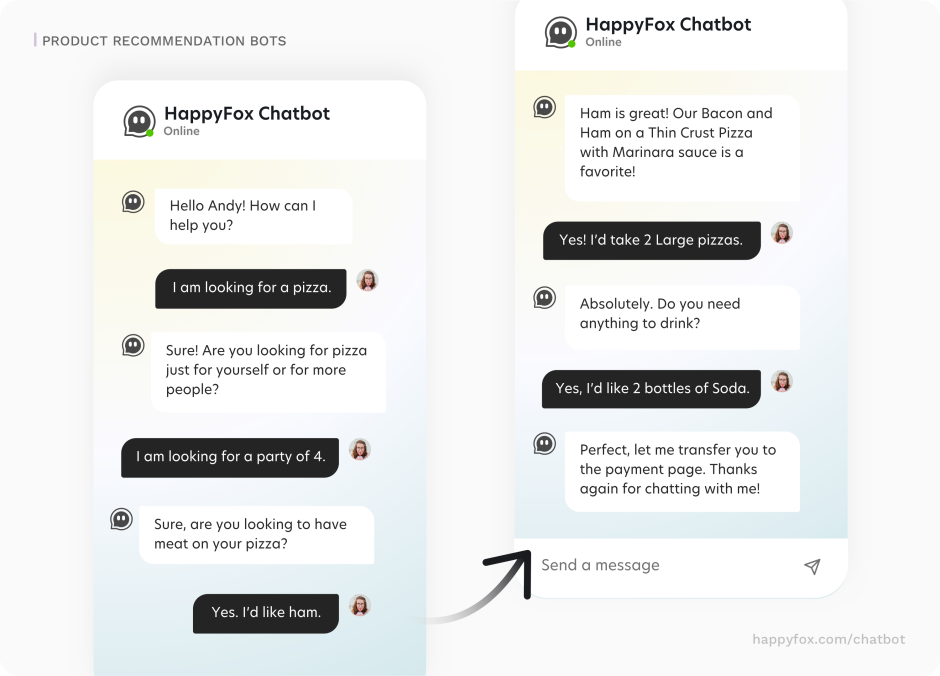
3.3. Assisting With the Checkout Process
Abandoned carts are every e-commerce retailer’s worst nightmare.
But fear not—chatbots are here to save the day.
By proactively engaging with customers who have items sitting in their carts, chatbots can offer assistance.
They even answer questions, and even provide incentives to complete the purchase.
Whether it’s offering a discount code or providing reassurance about shipping and returns, chatbots help nudge hesitant customers toward the checkout button.
This helps in reducing cart abandonment rates and driving conversions.
3.4. Leveraging Chatbots for Lead Generation and Nurturing
In the world of digital marketing, leads are the lifeblood of business growth.
And chatbots are expert lead generators. By engaging with website visitors, answering questions, and collecting contact information, chatbots help businesses capture valuable leads in real time.
But chatbots aren’t just about quantity—they’re also about quality.
By nurturing leads with personalized follow-ups, targeted content, and timely reminders, chatbots ensure that potential customers stay engaged.
Moreover, they help them move smoothly through the sales funnel, ultimately converting into loyal customers.
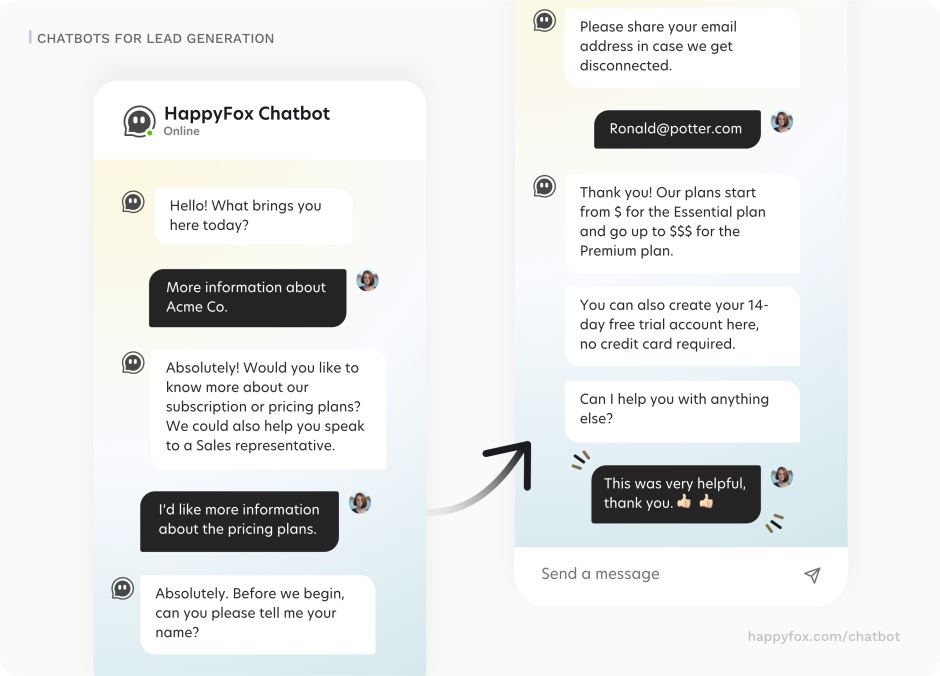
In summary, chatbots are not just tools for customer service—they’re powerful drivers of conversions. Ready to supercharge your conversion rates?
Let’s explore some innovative chatbot strategies next.
4: Innovative Use Cases of Chatbots in Digital Marketing
4.1. Interactive Storytelling: Using Chatbots to Deliver Immersive Brand Experiences
Move over, to traditional marketing campaigns—interactive storytelling is the new kid on the block.
Chatbots are transforming the way brands connect with their audience by delivering immersive, interactive brand experiences.
Whether it’s guiding users through a choose-your-own-adventure-style narrative or allowing them to interact with fictional characters, chatbots bring stories to life in a way that captivates audiences like never before.
4.2. Gamification: Engaging Customers Through Interactive Games and Quizzes
Who says marketing has to be boring?
With chatbots, brands can gamify the customer experience, turning mundane tasks into fun and engaging activities.
From trivia quizzes to scavenger hunts to spin-the-wheel games, chatbots offer endless opportunities for brands to entertain, educate, and incentivize their audience.
By tapping into the power of gamification, brands can increase engagement, build brand loyalty, and drive conversions in a way that feels like play, not work.
4.3. Virtual Shopping Assistants: Helping Customers Make Informed Purchase Decisions
Shopping online can be overwhelming, with endless options and choices to navigate. Enter chatbots, the ultimate shopping sidekick.
By providing personalized product recommendations, answering questions about features and specifications, and offering style advice and sizing guidance, chatbots help customers make informed purchase decisions with confidence.
Whether it’s finding the perfect outfit, selecting the right tech gadget, or discovering a new skincare routine, chatbots make shopping a breeze.
4.4. Social Media Integration: Utilizing Chatbots to Drive Engagement on Social Platforms
Social media is where the party’s at—and chatbots are the life of the party.
By integrating chatbots into social platforms like Facebook Messenger, Instagram, and Twitter, brands can engage with their audience in real time.
They can also deliver personalized content, and even facilitate transactions—all without ever leaving the app.
Whether it’s answering customer inquiries, running contests and giveaways, or providing customer support, chatbots turn social media interactions into meaningful engagements.
That function usually drives brand awareness and loyalty quite high.
In summary, chatbots are not just tools for customer service and support—they’re versatile marketing assets that can revolutionize the way brands connect with their audience.
Ready to take your marketing strategy to the next level?
Let’s explore these innovative chatbot uses with real-world examples.
5: Case Studies and Success Stories
5.1. Highlighting Real-World Examples of Businesses Effectively Using Chatbots in Digital Marketing
A. Sephora’s Virtual Assistant
Sephora, the beauty retailer, implemented a chatbot on their website and mobile app to provide personalized beauty recommendations and makeup tutorials.
Customers can chat with the virtual assistant to find products tailored to their skin type, and makeup preferences, and even receive step-by-step tutorials on how to achieve specific looks.
B. LEGO’s Messenger Bot
LEGO introduced a chatbot on Facebook Messenger to engage with their audience playfully and interactively.
The bot allows users to build virtual LEGO sets, receive product recommendations based on their interests, and even participate in themed challenges and competitions.
C. H&M’s Style Assistant
H&M launched a chatbot on the Kik messaging app to help users discover new fashion trends and find the perfect outfit.
The bot asks users a series of questions about their style preferences, budget, and occasion, then suggests curated outfits from H&M’s collection, complete with direct links to purchase.
5.2. Metrics Of Chatbots In Digital Marketing: Engagement Rates, Conversion Rates, and Customer Satisfaction Scores
Increased Engagement Rates:
According to a study, businesses using chatbots report a 48% increase in website engagement.
By providing instant responses and personalized recommendations, chatbots keep users engaged and encourage them to spend more time interacting with the brand.
Improved Conversion Rates:
OutGrow found that businesses using chatbots see a 67% increase in qualified leads.
By guiding users through the sales funnel, offering product recommendations, and assisting with the checkout process, chatbots help convert website visitors into paying customers.
Enhanced Customer Satisfaction Scores:
Reports that 42% of customers prefer chatbots for their customer service needs.
By providing round-the-clock support, delivering instant responses, and personalizing interactions, chatbots improve customer satisfaction scores and foster long-term loyalty.
In short, these case studies demonstrate the tangible benefits of implementing chatbots in digital marketing.
Now let’s explore how you can leverage this technology for your own business.
6: Best Practices for Implementing Chatbots in Digital Marketing
6.1. Choosing the Right Chatbot Platform
When it comes to selecting a chatbot platform, it’s essential to consider factors such as functionality, scalability, and integration capabilities.
Choose a platform that aligns with your business goals and technical requirements, whether it’s a DIY solution like Chatfuel or a more advanced platform like Dialogflow or IBM Watson.
Evaluate features such as natural language processing, multichannel support, and analytics to ensure the platform meets your needs now and in the future.
6.2. Designing Conversational Flows that Align with Your Brand Voice
Your chatbot is an extension of your brand, so it’s crucial to design conversational flows that reflect your brand voice and personality.
Whether your brand is casual and friendly or professional and informative, ensure that your chatbot’s tone and language are consistent with your overall brand identity.
Create a style guide outlining key messaging principles, tone of voice guidelines, and common phrases to maintain coherence across all interactions.
6.3. Continuously Optimizing Chatbot Performance Based on Analytics
The key to a successful chatbot strategy? Data, data, data.
Continuously monitor and analyze chatbot performance metrics such as response times, user engagement, and conversion rates to identify areas for improvement.
Use A/B testing to experiment with different messaging strategies, conversational flows, and call-to-action prompts to optimize performance. Overall, it drives better results in the long term.
6.4. Ensuring Compliance with Data Privacy Regulations
Last but certainly not least, ensure that your chatbot complies with data privacy regulations such as GDPR and CCPA.
Implement security measures such as encryption, data anonymization, and user consent mechanisms to protect customer data and maintain trust.
Keep abreast of regulatory changes and update your chatbot’s privacy policies and procedures accordingly to ensure compliance and mitigate legal risks.
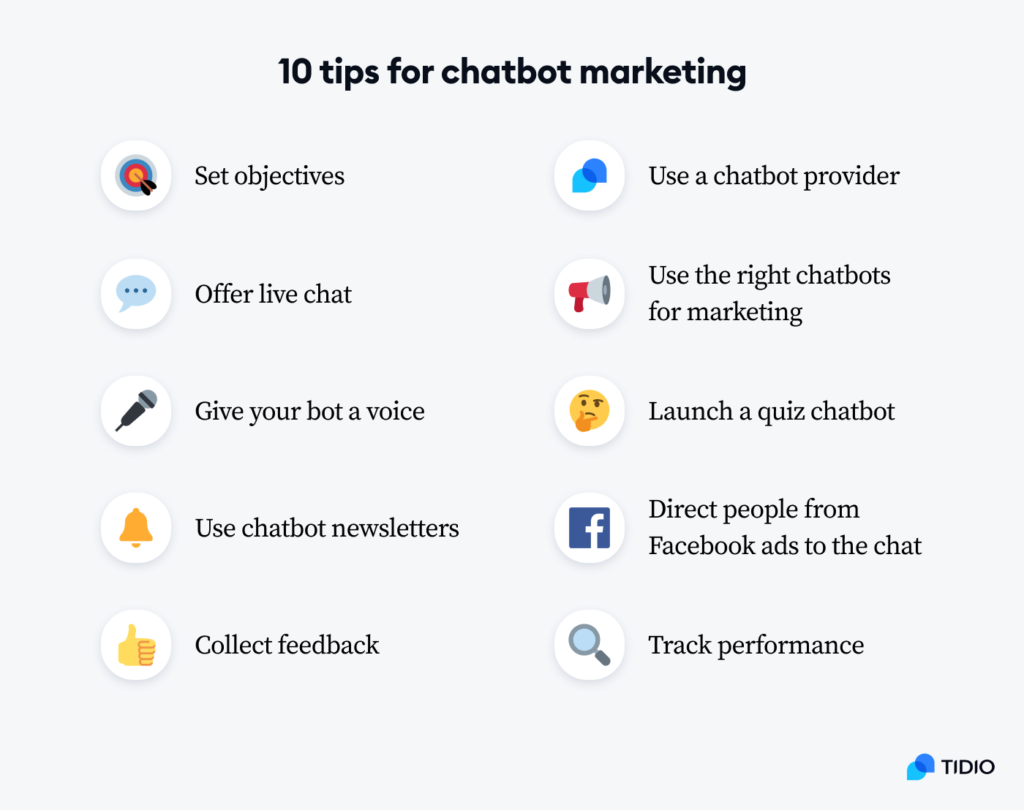
In summary, implementing a chatbot in your digital marketing strategy requires careful planning, strategic execution, and ongoing optimization.
FAQs
1.What makes chatbots crucial for digital marketing?
It gathers leads, takes orders on your website or a preferred messaging app, and automates the promotion of your products. Some things to bear in mind are: Chatbots for marketing can increase sales, generate leads, and offer round-the-clock customer support, among other advantages.
2. What impact do chatbots have on digital marketing?
These AI-driven virtual assistants are intended to mimic human communication and offer prompt answers to customer inquiries. Chatbots function as a middleman between businesses, influencers, and their followers in the context of influencer marketing.
3. What is a chatbot’s most crucial component?
The most crucial element is intents, which attempt to ascertain the user’s desires. What do they want? Stated differently, they record the user’s intention or objective. For instance, we could specify the purpose of a welcome and provide Watson with several sample greetings.
4. How can chatbots in digital marketing assist users?
Artificial intelligence (AI) and machine learning are used by a customer care chatbot to respond to inquiries from users. AI chatbots are useful tools for customer care because they offer a self-service alternative that lets users find the information they need without having to wait on an agent.
Related Posts
Data Privacy in Digital Marketing: Protecting Your Digital Privacy
2024 Digital Marketing Predictions: What to Expect in the Coming Year
Best Ways to Improve Your Social Media Strategy
The Psychology of Persuasion in Digital Marketing: Understanding Consumer Behavior
Conclusion
In essence, chatbots have emerged as powerful tools for businesses looking to enhance customer engagement, drive conversions, and deliver exceptional experiences.
Their ability to provide instant, personalized interactions across various touchpoints makes them invaluable assets in today’s digital landscape.
So, I suggest you invest time to harness the power of chatbots for your own business! Explore chatbot solutions that align with your goals and objectives, and embark on a journey to transform your digital marketing strategy.
Whether you’re looking to increase engagement, boost conversions, or improve customer satisfaction, chatbots can help you achieve your objectives and stay ahead of the competition.

